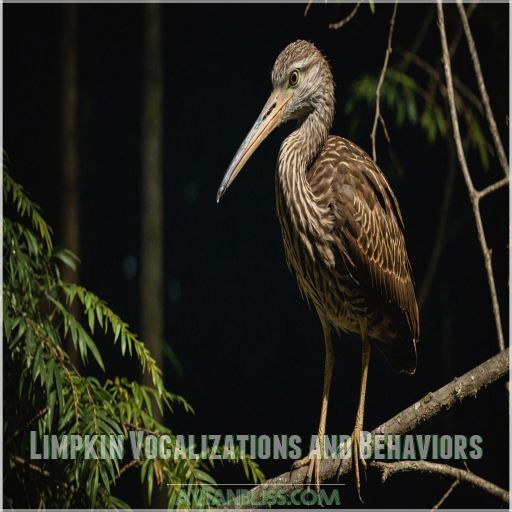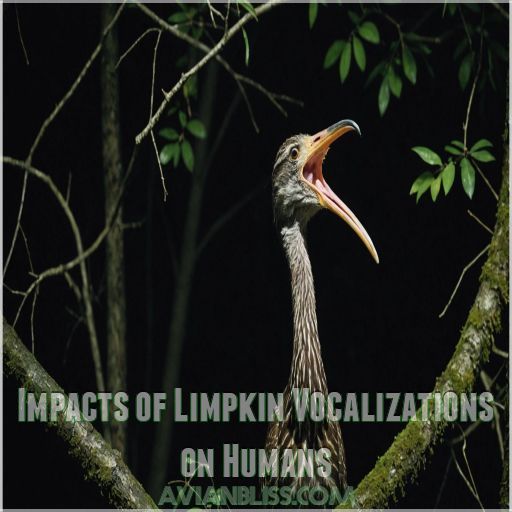This site is supported by our readers. We may earn a commission, at no cost to you, if you purchase through links.

Well, these wading birds have a unique adaptation – a long, looped windpipe that lets them belt out their haunting calls.
Limpkins use these loud vocalizations to attract mates and defend their territory, especially during breeding season.
While their nighttime cries may disturb your slumber, remember – these charismatic creatures are just doing what comes naturally to survive and thrive.
With a little eco-friendly planning, you and the limpkins can learn to coexist peacefully.
Now, are you curious to discover more about these fascinating feathered friends?
Table Of Contents
- Key Takeaways
- Limpkin Vocalizations and Behaviors
- Limpkin Mating and Breeding Behaviors
- Environmental Factors Influencing Limpkin Vocalization
- Impacts of Limpkin Vocalizations on Humans
- Limpkin Conservation and Management
- Frequently Asked Questions (FAQs)
- Do limpkins scream at night?
- What could be the cause of waking up screaming?
- Why do limpkins make a groaning sound?
- Are limpkins active during the day?
- Why is the Limpkin screaming?
- Do Limpkins make noise at night?
- Why does my bird keep screaming at night?
- What kind of bird makes a loud screaming noise at night?
- Are limpkins considered nuisance birds in some areas?
- What time of day are limpkins most vocal?
- Can limpkins cause property damage with their calls?
- How do limpkins compare to other wading bird species?
- Are there any effective ways to deter limpkins from an area?
- Conclusion
Key Takeaways
- Limpkins let out their eerie, human-like wails to attract mates and defend their territory, especially during the noisy breeding season when they are busy finding partners and raising chicks. Don’t worry, their bone-chilling calls are just part of nature’s symphony!
- Limpkins’ unique double-looped windpipes give their vocalizations that haunting, distressed sound that may keep you up at night. But these distinctive calls serve important purposes, like warning of predators and communicating with their mates.
- Changes to limpkins’ wetland habitats, like habitat loss and invasive species, can increase their nighttime screeching as they struggle to find food and mates. Restoring wetlands is crucial to help these fascinating birds thrive.
- While limpkins’ nighttime noise can be a real nuisance, there are eco-friendly ways to coexist – from using earplugs to trying wildlife deterrents. By understanding these birds’ behaviors, we can all find practical solutions that let limpkins be limpkins without losing our beauty sleep.
Limpkin Vocalizations and Behaviors
Have you ever been kept up all night by a screeching sound that makes it seem like someone’s being strangled?
Well, that’s the unique call of the limpkin, a wading bird found in Florida’s wetlands and the southeastern U.S.
Limpkins use these loud, distinctive vocalizations to attract mates and communicate, especially during the spring breeding season.
Characteristics of Limpkin Calls
Frequently, you’ll hear the limpkin’s eerie wails across wetlands as it hunts for apple snails, its primary prey.
This gangly brown bird has a distinctive, twisted bill perfect for extracting mollusks from their shells.
Its double-looped trachea produces these haunting calls, a unique adaptation among birds, similar to the specialized features of marsh birds with long legs. (Source)
Reasons for Limpkin Vocalizations
Limpkins use a wide range of vocalizations for mating, territorial defense, and signaling alarm or food competition.
Their distinctive "wailing" calls echo through wetlands, and their doubly looped trachea may contribute to their unique sound.
Limpkins have even lent their voices to iconic movie monsters like the Hippogriff in Harry Potter.
Timing and Frequency of Limpkin Calls
When darkness falls, you may hear an eerie scream echoing through the wetlands. That’s the call of the limpkin, a crane-like bird. They vocalize most often during mating season and at dawn and dusk. Their calls serve to mark territory, attract mates, and communicate with their partners. These nocturnal screams can startle even the bravest soul!
- Limpkins use their distinctive calls to defend their territory
- Male limpkins produce loud, repetitive wails and screams
- Females may respond with softer groans to coordinate with their mates
- Limpkin calls intensify during the breeding season, especially at dawn and dusk
Limpkin Mating and Breeding Behaviors
You’ll be surprised to learn that the limpkins’ intense, wailing cries you hear all night long are actually part of their mating rituals.
As these quirky birds seek mates during the spring, their distinctive and downright eerie calls fill the air, creating quite a ruckus that may keep you up at night with their wailing cries.
Limpkin Mating Season
Delighting in their whimsical mating season, limpkins court through the night with their unmistakable cries.
Nesting between February and June, these charismatic birds build cozy abodes in a variety of coastal salt marshes wetland habitats. Females may even "cheat" on their mates, engaging in serial polyandry to expand their breeding prospects (Source).
| Season | Nesting Timing | Egg Count |
|---|---|---|
| North FL | Feb – May | 4 – 8 |
| Central FL | Jan – Mar | 4 – 8 |
| South FL | Earlier than Central | 4 – 8 |
Limpkin Courtship and Pair Formation
Delighted to discover the intriguing mating rituals of limpkins!
You’ll be amazed by their courtship dance – the male brings food and trinkets to the female, wooing her with his charming displays.
Once a pair forms, they’re devoted partners, working together to build a cozy nest and raise their young.
Limpkin Nesting and Chick Rearing
As a limpkin, your nest may sit on a platform of woven reeds and twigs, tucked away in the marsh grasses or shrubs.
Your chicks will hatch covered in downy feathers, soon venturing out to explore their watery world.
You’ll vigilantly protect your young, sounding loud alarm calls to ward off predators.
Raising a family in the swamps is no easy task, but your dedicated parenting will see them through, a testament to dedicated parenting.
Environmental Factors Influencing Limpkin Vocalization
You might be surprised to learn that environmental factors, like changes in habitat and food sources, can cause limpkins to let out their infamous screeches all through the night.
While these factors may seem innocuous, they can drive limpkins to vocalize more frequently, so you’re stuck listening to their bone-chilling calls.
Habitat and Habitat Changes
You may have noticed those raucous limpkins wailing all night long. What’s their deal?
Changes to the limpkin’s wetland habitats, like drainage and fragmentation, force them to adapt. Limpkin populations are declining due to the loss of their apple snail food source.
Restoring wetlands is essential to support these unique birds.
| Habitat Change | Impact |
|---|---|
| Wetland Drainage | Limpkin population decline |
| Habitat Fragmentation | Reduced breeding success |
| Apple Snail Loss | Lack of food |
Availability of Food Sources
The limpkin’s tasty diet of apple snails is sadly dwindling due to habitat loss and invasive species.
But don’t worry, these resourceful birds have a few tricks up their sleeve:
- They’ll switch to eating freshwater mussels and other small critters when snails are scarce.
- They use their unique, curved bills to pry open shells.
- With fewer apple snails around, limpkins may call out more at night to find mates and defend their territory.
Interactions With Other Species
Ever wonder why limpkins let out their eerie, pterodactyl-like screeches all night long?
It turns out their calls are often a response to interactions with other species, which is a common communication need among birds, as they use their vocalizations to warn of danger, alerting the flock to potential threats and guaranteeing everyone’s safety.
Limpkins may scream to mark territory, communicate with mates, or even warn of predators lurking nearby, and their unusual vocalizations can be a result of millions of years of evolution, honed to guarantee the survival of their species through complex bird vocalizations.
Their unusual vocalizations are just part of life in the wetlands!
| Interaction | Effect on Limpkin Calls | Frequency |
|---|---|---|
| Predator presence | Increased alarm calls | Occasional |
| Competing species | Territorial displays | Frequent |
| Mating behaviors | Courtship and pair bonding | Seasonal |
| Feeding competition | Aggressive vocalizations | Periodic |
Impacts of Limpkin Vocalizations on Humans
You may have heard the Limpkin’s bone-chilling wail echoing through the night.
While these birds’ vocalizations can be jarring, understanding their behaviors can help you cope with the unexpected serenade.
As mating season approaches, these fascinating creatures ramp up their nighttime calls, but fortunately, the noise usually subsides after their courtship is complete.
Noise Disturbance and Sleep Disruption
Alright, have you ever been kept up at night by the ear-piercing scream of a limpkin?
These noisy birds can disrupt your sleep and drive you mad.
But don’t fret – their incessant wailing actually serves important purposes, like finding mates and defending their territory.
Just grab some earplugs and hang in there!
Community Responses and Proposed Solutions
Your local limpkin might be keeping the whole neighborhood up at night, but don’t fret – your community has options.
Some residents have reported success with noise-cancelling earplugs, soundproofing, or even approaching wildlife authorities about deterrents.
With a little creativity, you can reclaim your peaceful night’s sleep while respecting the limpkins’ place in nature.
Balancing Conservation and Human Needs
Balancing the needs of nature and humans can be a tricky endeavor.
While limpkins’ eerie nighttime cries may disturb your sleep, their unique vocalizations are integral to their survival.
By embracing ethical coexistence strategies, like habitat management and community engagement, we can find practical solutions that preserve these fascinating birds without sacrificing your peace and quiet.
Limpkin Conservation and Management
Are you tired of those limpkins screeching at all hours of the night?
Don’t worry – wildlife experts working on burrowing owl conservation are working hard to protect these unique birds and their habitats, ensuring we can all enjoy their calls (or at least tolerate them) for years to come.
Population Trends and Distribution
Despite their shrinking habitat, limpkin populations seem stable in Florida, their stronghold.
Records suggest the species once had a wider distribution, reaching as far north as Mississippi and Texas.
Yet sightings outside Florida and southern Georgia remain rare, likely due to the limpkin’s specialized diet of apple snails and other mollusks.
Protection Status and Regulations
Limpkins may no longer be listed as endangered, but they’re still part of Florida’s Imperiled Species Management Plan.
While federal protections have lifted, state laws safeguard these unique birds.
Enjoy listening to their haunting nighttime calls, but remember – don’t disturb them or their habitats.
Respecting limpkins’ space helps keep these fascinating creatures thriving (Source).
Habitat Preservation and Restoration Efforts
Efforts to preserve and restore limpkin habitats are essential for the species’ survival, as human activities like keeping wild birds as pets can sometimes inadvertently harm them, highlighting the importance of learning about wild bird permits.
This includes managing wetlands, controlling invasive apple snails, and maintaining habitat connectivity.
While limpkin populations have rebounded, ongoing threats like pollution and habitat loss require vigilance.
Your backyard wetland could be a haven for these unique birds.
Frequently Asked Questions (FAQs)
Do limpkins scream at night?
Intriguing cries? Certainly! Limpkins’ lilting laments linger late into the night, their distinct, distressed-sounding dirges delighting – or perhaps disturbing – denizens of Florida’s fantastic forests.
What could be the cause of waking up screaming?
You may wake up screaming due to sleep terrors, a condition where your brain’s partly awake and partly asleep, causing panic or fear.
This can stem from stress, medications, or sleep disorders.
Why do limpkins make a groaning sound?
A fascinating avian trait, the limpkin’s groaning sound emanates from its unique looping windpipe, marking territory and romancing mates in melodic duets.
These wetland wonders have an appetite for apple snails, leaving evidence in telltale shell piles.
Are limpkins active during the day?
While limpkins are more active at dawn, dusk, and night, they may venture out during the day in places where they don’t fear humans, like parks and refuges.
Just don’t expect to see them straying far from cover.
Why is the Limpkin screaming?
As the old saying goes, "the early bird catches the worm" – or in this case, the "crying bird" makes its distinctive call at dawn and dusk to mark its territory.
Don’t lose any sleep over it; it’s just nature’s way.
Do Limpkins make noise at night?
Limpkins do indeed make a lot of noise at night, often letting out a startling, human-like wail or scream to mark their territory.
This odd vocalization helps these unique birds stand out, even if it keeps you awake!
Why does my bird keep screaming at night?
One moment, your feathered friend’s nighttime caterwauls might startle you, but these screeches likely signal a key bird behavior.
Though their shrieking sounds alarming, they’re just protecting their territory and calling for a mate.
What kind of bird makes a loud screaming noise at night?
Chances are, that startling scream in the night is likely a limpkin, a crane-like wetland bird known for its distinctive, high-pitched wails that sound eerily human-like.
Are limpkins considered nuisance birds in some areas?
They may not be the most harmonious neighbors, but limpkins’ voracious appetite for invasive apple snails makes them more friend than foe in certain areas.
Though their loud calls can be a nuisance, their ecological benefits tend to outweigh the noise.
This has a positive impact, and is referenced.
What time of day are limpkins most vocal?
You’re most likely to hear limpkins‘ haunting, human-like wails around dawn and dusk, as these wetland birds use their calls to mark their territory.
Their distinct cries make quite a racket!
Can limpkins cause property damage with their calls?
While limpkins‘ loud, eerie calls may startle you at night, they generally don’t cause property damage.
These wetland birds use their distinctive screeches to mark territory, not to disrupt your sleep.
How do limpkins compare to other wading bird species?
Limpkins are unique, as they’re the sole surviving member of their avian family.
Unlike other wading birds, their curved beaks are perfectly adapted to snatch up apple snails – their primary food source.
Are there any effective ways to deter limpkins from an area?
Scared off limpkins with decoys, reflective materials, and chemical repellents that’ll make ’em turn up their beaks and buzz off for good.
Trimming aquatic plants and removing their favorite snails helps too.
Conclusion
Did you know that limpkins can call up to 2,000 times per night during breeding season?
While their haunting screeches may keep you awake, these feathered friends are simply doing what comes naturally to attract mates and defend their territory.
With a little understanding and eco-friendly planning, you and the limpkins can learn to coexist peacefully.
The next time you hear those limpkin screams at night, remember – it’s just nature’s chorus in action, during the breeding season.








